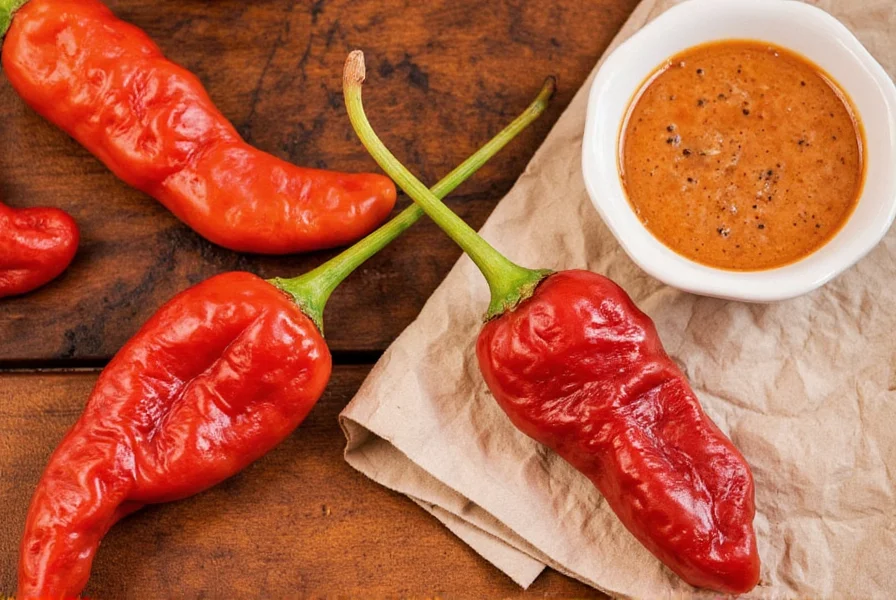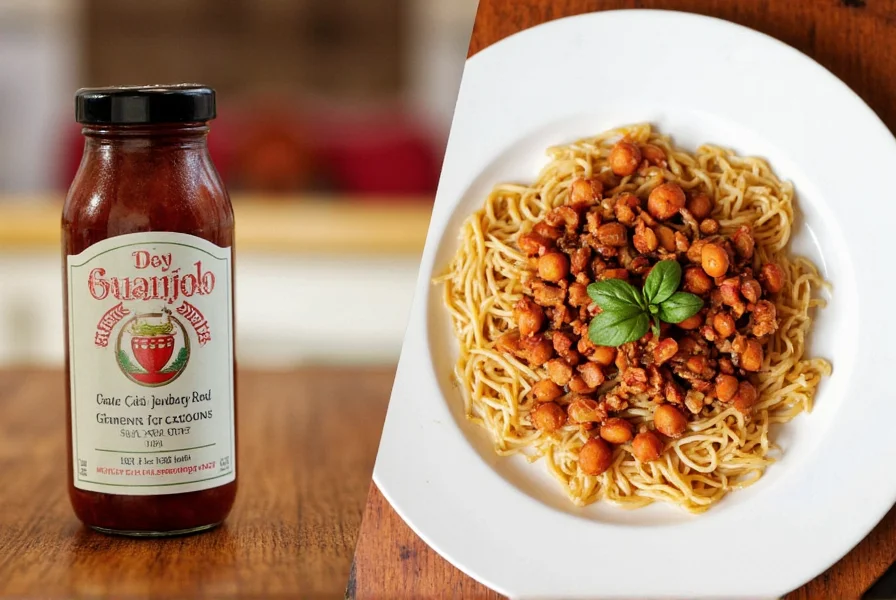Guajillo and California chiles are two popular dried peppers with distinct heat levels, flavors, and culinary uses. Guajillo (2,500-5,000 SHU) offers bold, complex flavors perfect for mole sauces and traditional Mexican dishes, while California chiles (500-1,000 SHU) provide mild, sweet notes ideal for everyday meals and kid-friendly recipes. In this guide, we'll compare these two chilies in detail, so you can choose the right one for your next dish.

Table of Contents
- What is Chile Guajillo?
- What is Chile California?
- Head-to-Head: Flavor, Heat & Use Cases
- Storage & Usage Hacks for Both Chilies
- Buying Guide: Choosing the Best for Your Kitchen
- Frequently Asked Questions
- Final Verdict: Which One Should You Reach For?
| Feature | Guajillo | California |
|---|---|---|
| Heat Level (SHU) | 2,500 – 5,000 | 500 – 1,000 |
| Flavor Profile | Berries, Tea, Smoky Earthiness | Mild, Nutty, Slightly Sweet |
| Origin | Mexico (dried Mirasol pepper) | United States (bred for mild heat) |
| Best For | Rich sauces, Mole, Marinades | Enchiladas, Red Rice, Kids' Meals |
| Color After Rehydration | Bright Red | Deep Maroon |
| Texture | Thinner Skin, More Fragile | Thicker, Meatier Flesh |
| Common Substitutes | Ancho, Pasilla | Poblano, New Mexico |
| Price Range | $3–$6 per ounce | $2–$4 per ounce |
What is Chile Guajillo?
Originating from Mexico, the Guajillo chili is one of the most commonly used dried peppers in traditional Mexican cuisine. It's the dried form of the Mirasol chili and comes with a rich mahogany color and a moderately spicy kick. With an SHU (Scoville Heat Unit) range of around 2,500–5,000, it's considered medium-hot — not too mild, not too fiery.
But what really sets Guajillo apart is its flavor profile. Think tart berries, sun-dried tomatoes, and subtle hints of tea. It's earthy, slightly smoky, and brings a deep complexity to sauces, moles, soups, and marinades. This makes it a go-to for anyone wanting bold flavors without overwhelming heat.
Common Uses of Guajillo
- Salsas rojas
- Mole sauces
- Pozole rojo
- Adobo rubs
- Tamales fillings
What is Chile California?
The Chile California, also known as California Wonder or simply "Calif," may not be Mexican by origin, but it's certainly made a name for itself in many Mexican-style recipes. Originally bred in the United States, this chili is widely available in supermarkets across North America. Unlike Guajillo, it's much milder, sitting at about 500–1,000 SHU. That's less than half the heat of Guajillo!
In terms of taste, California chilies are more subdued — think gentle sweetness with a faint nutty background. There's little to no smoke and not much depth compared to Guajillo. But that doesn't mean they aren't useful! Their mildness makes them great for beginners or when you want a subtle red hue and slight chili flavor without overpowering other ingredients.

Common Uses of California
- Mild enchilada sauces
- Bean dishes
- Red rice recipes
- Lightly spiced soups
- Kid-friendly meals
Head-to-Head: Chile Guajillo vs California
When to Choose Guajillo
- You want a bold, complex base for sauces.
- You're making mole or traditional Mexican stews.
- You enjoy moderate spice with big flavor.
- You need a strong visual pop in your dish (bright red color).
When to Choose California
- You're new to cooking with dried chilies.
- You want to avoid too much heat for family members or guests.
- You're using it as a supporting ingredient rather than the star.
- You're going for texture rather than intense flavor.
Spice Storage & Usage Hacks
Dried chilies like Guajillo and California are shelf-stable, but proper storage can preserve their potency and aroma for months — even years. Here are some handy hacks to get the most out of your chilies:

Top 5 Storage Tips
- Store in airtight containers: Mason jars or sealed plastic bags keep moisture and light out.
- Keep in a cool, dark place: Pantry shelves work well — avoid windowsills or stove tops.
- Freeze for long-term use: Toss whole chilies into a ziplock bag and freeze to lock in flavor.
- Grind your own powder: Freshly ground chili powder has more punch than store-bought.
- Toaster before using: Lightly toast chilies in a dry pan to enhance their natural oils and aromas.
Usage Pro Tips
- Remove seeds and veins if you want less heat.
- Rehydrate in warm water or broth before blending.
- Use the soaking liquid in your sauce for extra depth.
- Combine with other chilies (like Ancho or Pasilla) for layered flavor profiles.
- Infuse oil or vinegar with these chilies for easy, homemade spice boosts.
Buying Guide: How to Pick the Perfect Pepper
Not all chilies are created equal. Whether you're shopping online or in a local market, here's how to choose the best ones for your needs.
For Chile Guajillo
- Look for: Deep red to maroon color, intact skin, no mold or soft spots.
- Avoid: Shriveled, overly brittle chilies that lack vibrancy.
- Best Brands: Goya, El Yeyo, Dona Maria
- Price Range: $3–$6 per ounce depending on quality and brand
- Best For: Traditionalists, chefs, and anyone looking to make authentic salsas or moles.
For Chile California
- Look for: Uniform size, smooth surface, consistent color.
- Avoid: Discolored or cracked chilies which may indicate age or poor storage.
- Best Brands: Badia, La Costeña, MexGrocer
- Price Range: $2–$4 per ounce; often cheaper than Guajillo due to availability.
- Best For: Families, beginner cooks, and those who prefer mild flavors without sacrificing color.
Buying Online? Know What You're Getting
- Read reviews for freshness and aroma notes.
- Check the country of origin if authenticity matters to you.
- Opt for vacuum-sealed packaging for longer shelf life.
- Buy in bulk only if you plan to use regularly.
Frequently Asked Questions
Can I substitute California chilies for Guajillo (or vice versa)?
Yes, but with caveats. California chilies are significantly milder than Guajillo (about 1/4 to 1/2 the heat), so you'll need to adjust quantities if substituting. For Guajillo's complex flavor, you might need to add additional spices like a touch of cumin or smoked paprika when using California chilies as a substitute. If using Guajillo instead of California, be prepared for more heat and deeper flavor - you may want to use fewer chilies or remove more seeds.
Which chili is hotter, Guajillo or California?
Guajillo is significantly hotter than California. Guajillo ranges from 2,500-5,000 SHU (Scoville Heat Units) while California chilies only reach 500-1,000 SHU. This means Guajillo can be 2.5 to 5 times hotter than California chilies.
What's the main flavor difference between Guajillo and California chilies?
Guajillo has a complex flavor profile with notes of tart berries, sun-dried tomatoes, and subtle hints of tea with earthy, slightly smoky undertones. California chilies are much milder with gentle sweetness and faint nuttiness, lacking the depth and complexity of Guajillo. Guajillo provides bold flavor while California offers subtle seasoning.
Can I use these chilies fresh instead of dried?
Guajillo starts as Mirasol peppers that are specifically dried to become Guajillo. California chilies are typically used fresh as "California Wonder" peppers (bell peppers), but when dried they become the milder California chili. For the authentic flavors described in this article, you should use them in their dried form as specified in traditional recipes.
Are Guajillo and California chilies the same thing?
No, they are completely different varieties. Guajillo comes from the Mirasol chili and is Mexican in origin, known for its medium heat and complex flavor. California chilies (not to be confused with California bell peppers) are milder, originally bred in the US, with a simpler flavor profile. They look somewhat similar when dried but have very different culinary properties.
Which one is better for making traditional Mexican mole sauce?
Guajillo is the traditional choice for many authentic mole recipes, particularly red moles. Its complex flavor profile with berry notes and earthiness provides the depth that's characteristic of traditional mole sauces. California chilies lack the necessary complexity and heat for authentic mole, though they might be used in some simplified or family-style versions.
Where can I buy authentic Guajillo and California chilies?
Authentic Guajillo chilies are best found in Mexican grocery stores, Latin markets, or specialty spice shops. Major supermarkets often carry California chilies (sometimes labeled as "California Mild" or just "California chilies"). For online options, look for reputable Mexican food retailers or specialty spice companies. When buying, check for deep color, intact skin, and avoid any with mold or excessive brittleness.
How do I properly rehydrate these chilies?
Remove stems and seeds first. Place chilies in a bowl and cover with hot (not boiling) water or broth. Weigh them down with a small plate to keep submerged. Let soak for 15-20 minutes until softened. Reserve the soaking liquid for your recipe as it contains flavorful compounds. Guajillo, with its thinner skin, may rehydrate slightly faster than the meatier California chilies.
Final Verdict: Chile Guajillo vs California – Who Wins?
So, which one should you reach for when planning your next spicy masterpiece? The answer really depends on your goals and taste preferences.
If you're after bold, robust flavor with a touch of heat and loads of character, then Chile Guajillo is your guy. It's ideal for traditional Mexican dishes where depth and richness are key.
On the flip side, if you're keeping things simple, serving kids, or just don't want the heat to dominate, go with Chile California. It's reliable, mild, and perfect for everyday meals where color and gentle spice matter more than complexity.

In short: both chilies deserve a spot in your pantry — just use them wisely according to your recipe and audience. And remember, the best spice is the one that makes your taste buds sing!
Now that you've got the lowdown, why not try swapping one for the other next time you're cooking? Spice up your routine and let your tastebuds explore the full spectrum of flavor!











 浙公网安备
33010002000092号
浙公网安备
33010002000092号 浙B2-20120091-4
浙B2-20120091-4